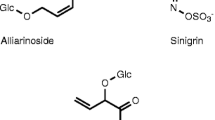Abstract
The ubiquitous occurrence of series of biosynthetically related plant secondary compounds within individual species has given rise to the suggestion that such multiplicity is adaptive; one possible mechanism that would serve to maintain such within-plant diversity is analog synergism. In a series of experiments, we provide evidence that synergism may account for the presence of multiple structurally related furanocoumarins in apiaceous plants. The black swallowtail, Papilio polyxenes, feeds exclusively on plant species containing furanocoumarins. Growth of larvae fed parsley leaves treated with both xanthotoxin and angelicin, two furanocoumarins that co-occur widely in swallowtail hostplants, was significantly slower than that of larvae fed leaves with an equimolar concentration of either xanthotoxin or angelicin. A multivariate combination of growth, food consumption and frass excretion differed significantly between larvae fed leaves treated with both xanthotoxin and angelicin and larvae fed leaves treated with angelicin alone. In addition, we measured rates of in vitro cytochrome P450-mediated metabolism of three furanocoumarins — bergapten, xanthotoxin, and angelicin. While bergapten and xanthotoxin, both linear furanocoumarins, were metabolized at similar rates (8.07 and 9.86 nmoles/min/g fw caterpillar, respectively), angelicin, an angular furanocoumarin, was metabolized more slowly (2.76 nmoles/min/g fw caterpillar). When all three furanocoumarins were assayed together, overall rates of metabolism were significantly reduced, suggesting substrate inhibition. Thus, the pattern of growth of larvae is consistent with the pattern of in vitro metabolism and is evidence in support of analog synergism. In a separate experiment, metabolism of xanthotoxin and angelicin individually and together were compared in six maternal families. Again, angelicin was metabolized more slowly than xanthotoxin and each furanocoumarin inhibited metabolism of the other. That significant family effects were found for rates of metabolism and for the ratio of moles of angelicin metabolized for each mole of xanthotoxin metabolized raises the possibility that genetic variation exists for the rate and specificity of metabolism and suggests that insect herbivores may be able to adapt to analog synergism.
Similar content being viewed by others
References
Becker WA (1984) Manual of Quantitative Genetics. 4th ed. Academic Enterprises, Pullman, Washington
Berenbaum M (1981) Patterns of furanocoumarin distribution and insect herbivory in the Umbelliferae: plant chemistry and community structure. Ecology 62: 1254–1266
Berenbaum MR (1985) Brementown revisited: interactions among allelochemicals in plants. Rec Adv Phytochem 19: 139–169
Berenbaum M, Feeny P (1981) Toxicity of angular furanocoumarins to swallowtail butterflies: escalation in a coevolutionary arms race. Science 212: 927–929
Berenbaum MR, Zangerl AR (1992) Genetics of physiological and behavioral resistance to host furanocoumarins in the parsnip webworm. Evolution 46: 1373–1384
Berenbaum MR, Zangerl AR, Nitao JK (1986) Constraints on chemical coevolution: wild parsnips and the parsnip webworm. Evolution 40: 1215–1228
Berenbaum MR, Nitao JK, Zangerl AR (1991) Adaptive significance of furanocoumarin diversity in Pastinaca sativa (Apiaceae). J Chem Ecol 17: 207–215
Brattsten LB (1983) Cytochrome P-450 involvement in the interactions between plant terpenes and insect herbivores. In: Hedin PA (ed) Plant Resistance to Insects. American Chemical Society, Washington, DC pp 173–195
Brattsten LB (1992) Metabolic defenses against plant allelochemicals. In: Rosenthal GA, Berenbaum MR (eds) Herbivores: Their Interactions with Secondary Plant Metabolites, Academic Press, NY, pp 175–242
Cohen MB (1991) Characterization of a hostplant-inducible cytochrome P450 from the black swallowtail caterpillar, Papilio polyxenes (Lepidoptera Papilionidae). PhD dissertation, University of Illinois, Urbana-Champaign
Cohen MB, Berenbaum MR, Schuler MA (1989) Induction of cytochrome P450-mediated detoxification of xanthotoxin in the black swallowtail. J Chem Ecol 15: 2347–2355
Cohen MB, Schuler MA, Berenbaum MR (1992) A host-inducible cytochrome P450 from a host-specific caterpillar: molecular cloning and evolution. Proc Natl Acad Sci 89: 10920–10924
Gould F (1984) Mixed function oxidases and herbivore polyphagy: the devil's advocate position. Ecol Ent 9: 29–34
Ivie GW, Bull DL, Beier RC, Pryor NW, Oertli EH (1983) Metabolic detoxification: Mechanism of insect resistance to plant psoralens. Science 221: 374–376
Ivie GW, Bull DL, Beier RC, Pryor NW (1986) Comparative metabolism of [3H] psoralen and [3H] isopsoralen by black swallowtail (Papilio polyxenes Fabr.) caterpillars. J Chem Ecol 12: 871–884
Krieger RI, Feeny PP, Wilkinson CF (1971) Detoxication enzymes in the guts of caterpillars: an evolutionary answer to plant defenses? Science 172: 579–581
Labbe G, Descatoire V, Letteron P, Degott C, Tinel M, Larrey D, Carrion-Pavlov Y, Geneve J, Amouyal G, Pessayre D (1987) The drug methoxsalen, a suicide substrate for cytochrome P-450, decreases the metabolic activation, and prevents the hepatotoxicity, of carbon tetrachloride in mice. Bioch Pharmacology 36: 907–914
Lederhouse RC (1981) The effect of female mating frequency on egg fertility in the black swallowtail, Papilio polyxenes asterius (Papilionidae). J Lep Soc 35: 266–277
McKey D (1979) The distribution of secondary compounds within plants. In: Rosenthal GA, Janzen DH (eds), Herbivores: Their Interaction with Secondary Plant Metabolites. Academic Press, NY, pp 55–133
Murray RDH, Mendez J, Brown SA (1982) The Natural Coumarins, John Wiley and Sons, Chichester, England
Raubenheimer D, Simpson SJ (1992) Analysis of covariance: an alternative to nutritional indices. Entomol Exp Appl 62: 221–231
Roush RT, Tabashnik BE (1990) Pesticide Resistance in Arthropods. Chapman and Hall, NY
Stadler E, Buser H-R (1984) Defense chemicals in leaf surface wax synergistically stimulate oviposition by a phytophagous insect. Experientia 40: 1157–1159
Tinel M, Belghiti J, Descatoire V, Amouyal G, Letteron P, Geneve J, Larrey D, Pessayre D (1987) Inactivation of human liver cytochrome P-450 by the drug methoxsalen and other psoralen derivatives. Biochem Pharmacology 36: 951–955
Yu SJ (1987) Microsomal oxidation of allelochemicals in generalist (Spodoptera frugiperda) and semispecialist (Anticarsia gemmatalis) insects. J Chem Ecol 13: 423–436
Waldbauer GP (1968) The consumption and utilization of food by insects. Adv Insect Physiol 5: 229–288
Zangerl AR (1990) Furanocoumarin induction in wild parsnip: evidence for an induced defense against herbivores. Ecology 71: 1926–1932
Zangerl AR, Nitao JK, Berenbaum MR (1991) Parthenocarpic fruits in wild parsnip: decoy defense against a specialist herbivore Evol Ecol 5: 136–145
Author information
Authors and Affiliations
Rights and permissions
About this article
Cite this article
Berenbaum, M.R., Zangerl, A.R. Furanocoumarin metabolism in Papilio polyxenes: biochemistry, genetic variability, and ecological significance. Oecologia 95, 370–375 (1993). https://doi.org/10.1007/BF00320991
Received:
Accepted:
Issue Date:
DOI: https://doi.org/10.1007/BF00320991




